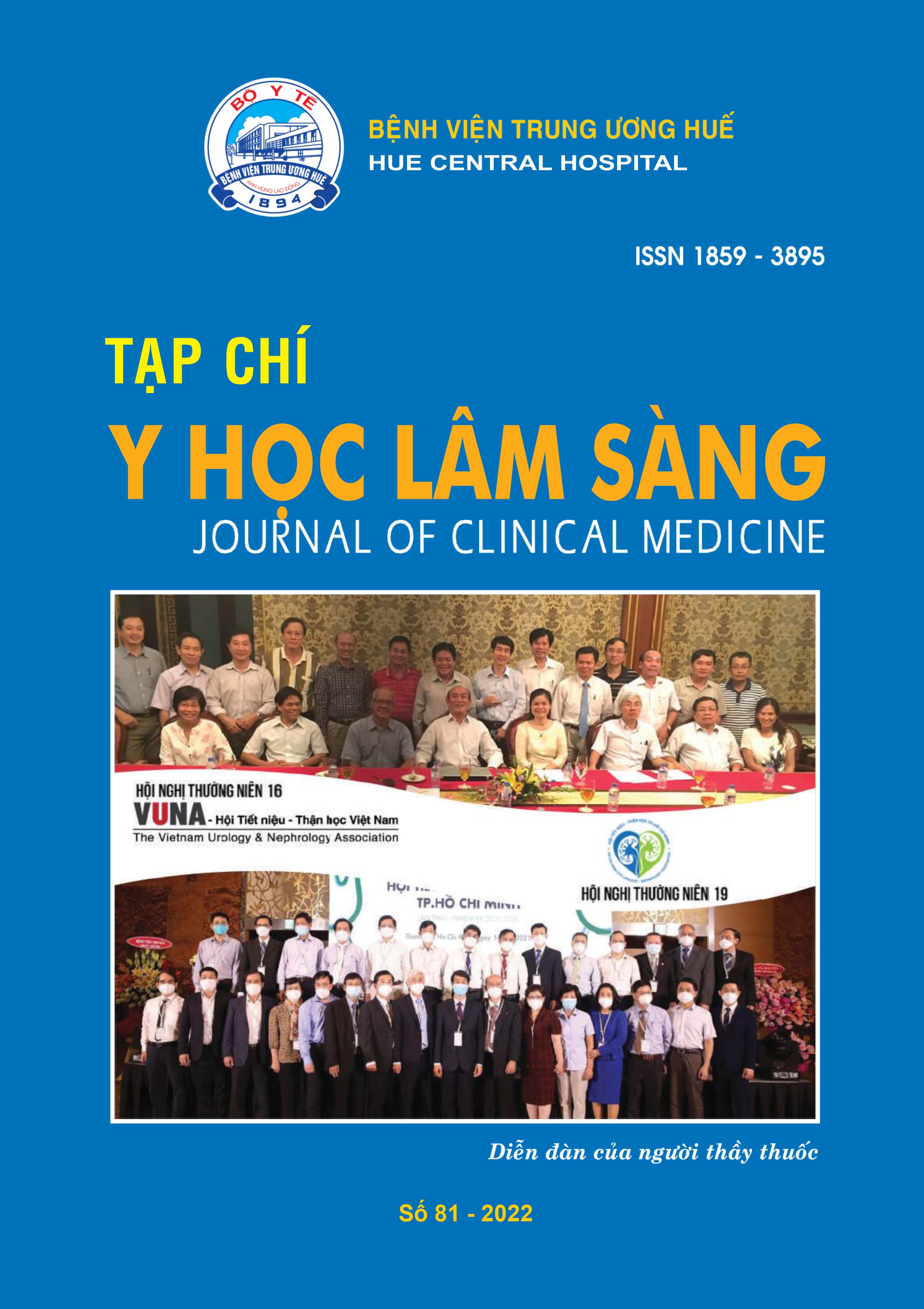Abstract
Background: Dyslipidemia can lead to cardiovascular complications and atherosclerosis, significantly reducing the survival of kidney transplant patients. The use of immunosuppressive drugs may affect blood lipid profile after kidney transplantation.
Objectives: To identify a proportion of kidney recipients presenting dyslipidemia and the impact of immunosuppressive drugs on their blood lipid profile. Patients and Methods: A cross - sectional, combined retrospective and prospective study conducted on 400 stable kidney recipients aged 18 years and older, both genders, followed up at the Department of Kidney Diseases and Dialysis, Viet Duc Hospital from 1/2021 to 12/2021. Patients who had combined organ transplantation, and graft failure were excluded from analysis. The values of lipid panel including Total Cholesterol (TC), Triglyceride (TG), High Density Lipoprotein - Cholesterol (HDL - C), Low Density Lipoprotein - Cholesterol (LDC - C) and related information have been collected. Dyslipidemia was defined as any lipid parameter felt outside the reference ranges or if the patient was on lipid - lowering medication.
Results: The proportion of patients presenting with dyslipidemia was 84,0%, with an increase in LDL - C was 51,4%, with an increase in TG was 49,0%, with combined abnormality of 3 lipid parameters was 16,9% and with abnormality of 4 parameters was 2,0%. The use of calcineurin inhibitors, mammalian target of rapamycin inhibitors increased the risk of dyslipidemia. Cyclosporin (CsA) increased the risk of dyslipidemia more than Tacrolimus (Tac) did. The risk of Mycophenolate (MPA), azathioprine (AZA) in causing dyslipidemia was not found.
Conclusions: Dyslipidemia was very common in kidney recipients and was influenced by immunosuppressive drugs. Individualization of immunosuppressive drugs for long - term use in kidney recipients should be considered
References
Neovius M, Jacobson SH, Eriksson J, Elinder CG, and Hylander B. Mortality in chronic kidney disease and renal replacement therapy: a population-based cohort study. BMJ Open 2014; 4(2): e004251
The Renal Association UK Renal Registry: 22nd Annual Report 2018; 04/08/2020;Availablefrom: https://www. renalreg.org/wp-content/uploads/2020/07/22nd_UKRR_ ANNUAL_REPORT_FULL.pdf
Santhi Voora, Deborah B. Management of kidney transplant recipients by general nephrologists: core curriculum 2019. AJKD. 2019; 73(6): 866-879
Hoitsma AJ, Hilbrands LB. Relative risk of new-onset diabetes during the first year after renal transplantation in patients receiving tacrolimus or CsAe immunosuppression. Clin Transplant. 2006; 20 (5), pp. 659-64.
Hart A, Smith JM, Skeans MA. OPTN/SRTR 2016 Annual Data Report: Kidney. Am J Transplant,18 Suppl 1:18-113. 10.1111 Hart A, Smith JM, Skeans MA. OPTN/SRTR 2016 Annual Data Report: Kidney. Am J Transplant. 2018;18 Suppl 1:18-113. 10.1111.
Horace RW, Robert M, Shireman TI, Merhi B, Jacques P, Bostom AG. Remnant cholesterol is prospectively associated with cardiovascular disease events and all-cause mortality in kidney transplant recipients: the FAVORIT study. NDT. 2022; 37: 382-389.
Badiou S, Cristol JP, and Mourad G. Dyslipidemia following kidney transplantation: diagnosis and treatment. Curr Diab Rep. 2009; 9 (4): 305-311
National Cholesterol Education Program (NCEP) Expert Panel on Detection, Evaluation, and Treatment of High Blood Cholesterol in Adults (Adult Treatment Panel III): Third report of the National Cholesterol Education Program (NCEP)Expert Panel on detection, evaluation, and treatment of high blood cholesterol in adults (Adult Treatment Panel III) final report. Circulation. 2002; 106:3143-3421.
Gonyea JE, Anderson CF. Weight Change and Serum Lipoproteins in Recipients of Renal Allografts. Mayo Clin Proc. 1992; 67: 653-657
Hosseini M, Rostami Z, and Einollahi B. Dyslipidemia After Kidney Transplantation and Correlation With CsA Level. Nephrourol Mon 2013; Jul 1; 5(3): 831-834
Garcez MR, Pereira JL, Fontanelli MM. Prevalence of dyslipidemia according to the nutritional status in a representative sample of Sao Paulo. Arg Bras Cardiol. 2014; 103(6): 476-484
Xi Y, Niu L, Cao N. Prevalence of dyslipidemia and associated risk factor among adults aged > 35 years in northern China: a cross-sectional study. BMC Public Health. 2020; 20:1068
AgarwalA, Ramesh GV. Post-transplant dyslipidemia: Mechanisms, diagnosis and management. World J Transplant. 2016; 6(1): 125-134
Tory R, Sachs-Barrable K, Goshko CB. Tacrolimusinduced elevation in plasma triglyceride concentrations after administration to renal transplant patients is partially due to a decrease in lipoprotein lipase activity and plasma concentrations. Transplantation. 2009; 88 (1):62-68
Despina N Perrea, Konstantinos G Moulakakis. Correlation between lipid abnormalities and immunosuppressive therapy in renal transplant recipients with stable renal function. Int Urol Nephrol. 2008; 40(2):521-7
Ekberg H, Bernasconi C, Tedesco-Silva H. Calcineurin inhibitor minimization in the Symphony study: observational results 3 years after transplantation. Am J Transplant. 2009; 9: 1876-1885
Spinelli GA, Felipe CR. Lipid Profile Changes During the First Year After Kidney Transplantation: Risk Factors and Influence of the Immunosuppressive Drug Regimen. Transplantation Proceedings2011; 43(10): 3730-3737.
Akman B, Uyar M. Lipid profile during azathioprine or mycophenolate mofetil combinations with cyclosporine and steroids. Transplant Proc. 2007; 39(1):135-7.
| Published | 05-01-2025 | |
| Fulltext |
|
|
| Language |
|
|
| Issue | No. 81 (2022) | |
| Section | Original article | |
| DOI | 10.38103/jcmhch.81.18 | |
| Keywords | Ghép thận, rối loạn lipid máu, thuốc ức chế miễn dịch Kidney Transplantation, Dyslipidemias, immunosuppressive drugs. |

This work is licensed under a Creative Commons Attribution-NonCommercial-NoDerivatives 4.0 International License.
Copyright (c) 2022 Journal of Clinical Medicine Hue Central Hospital

